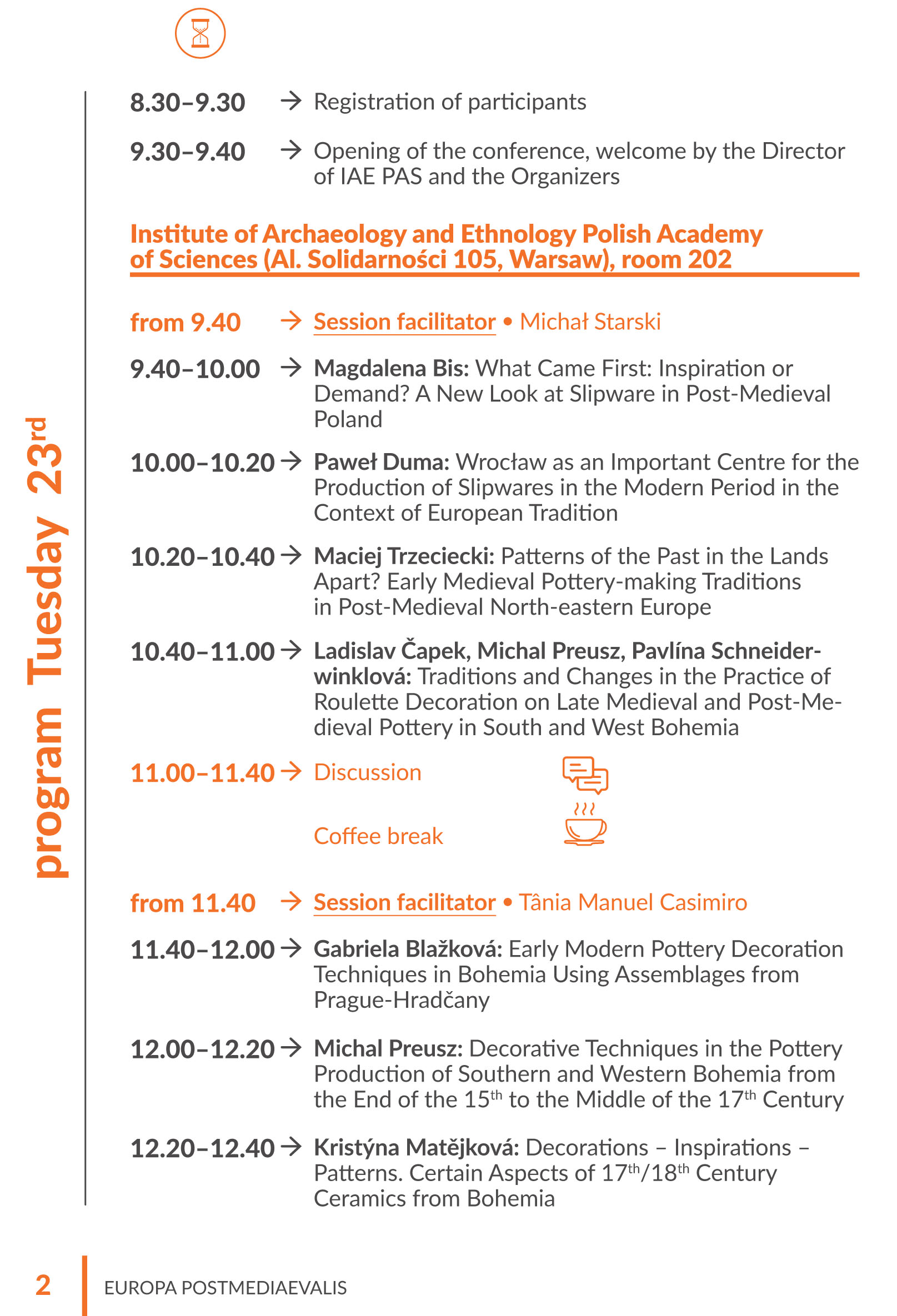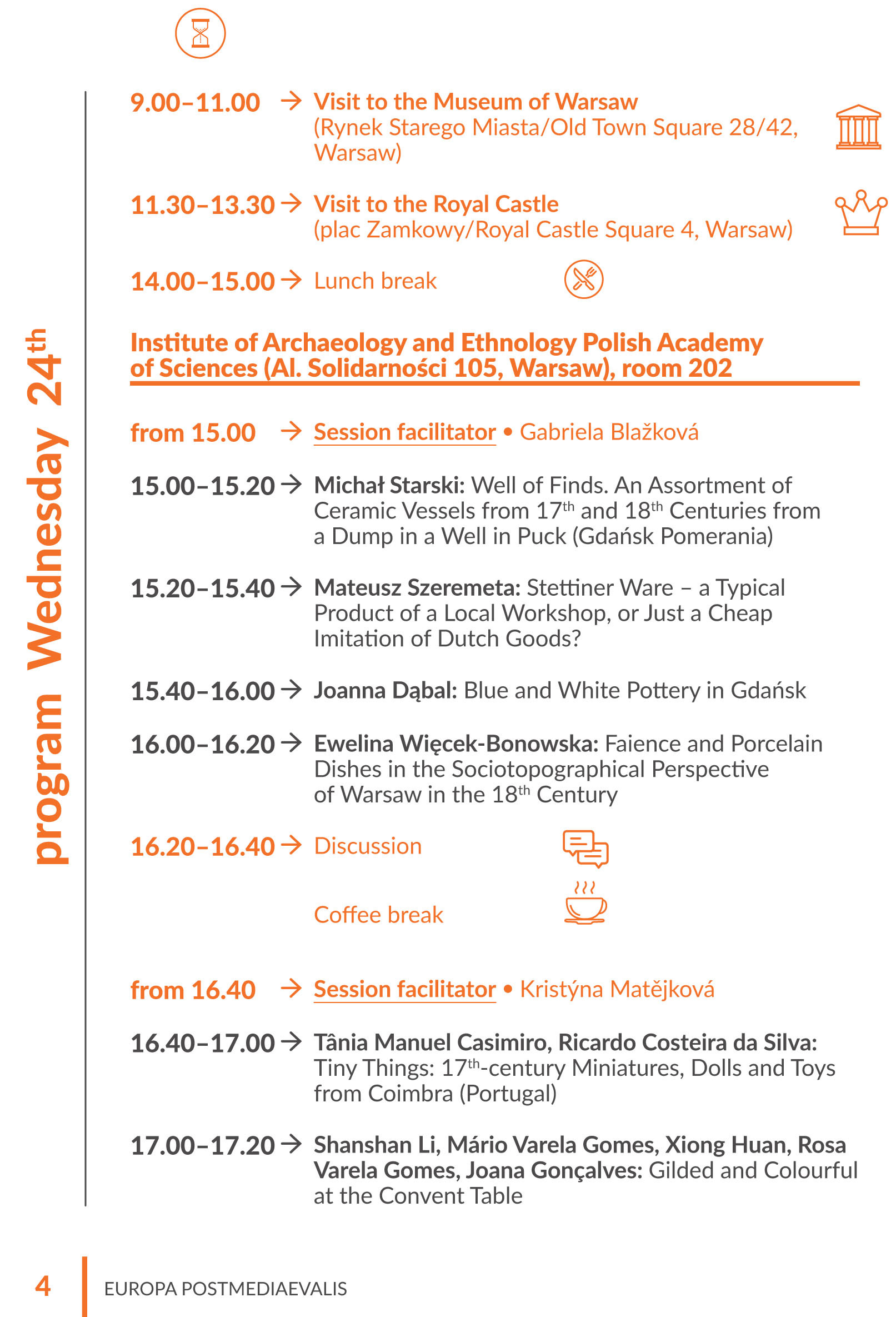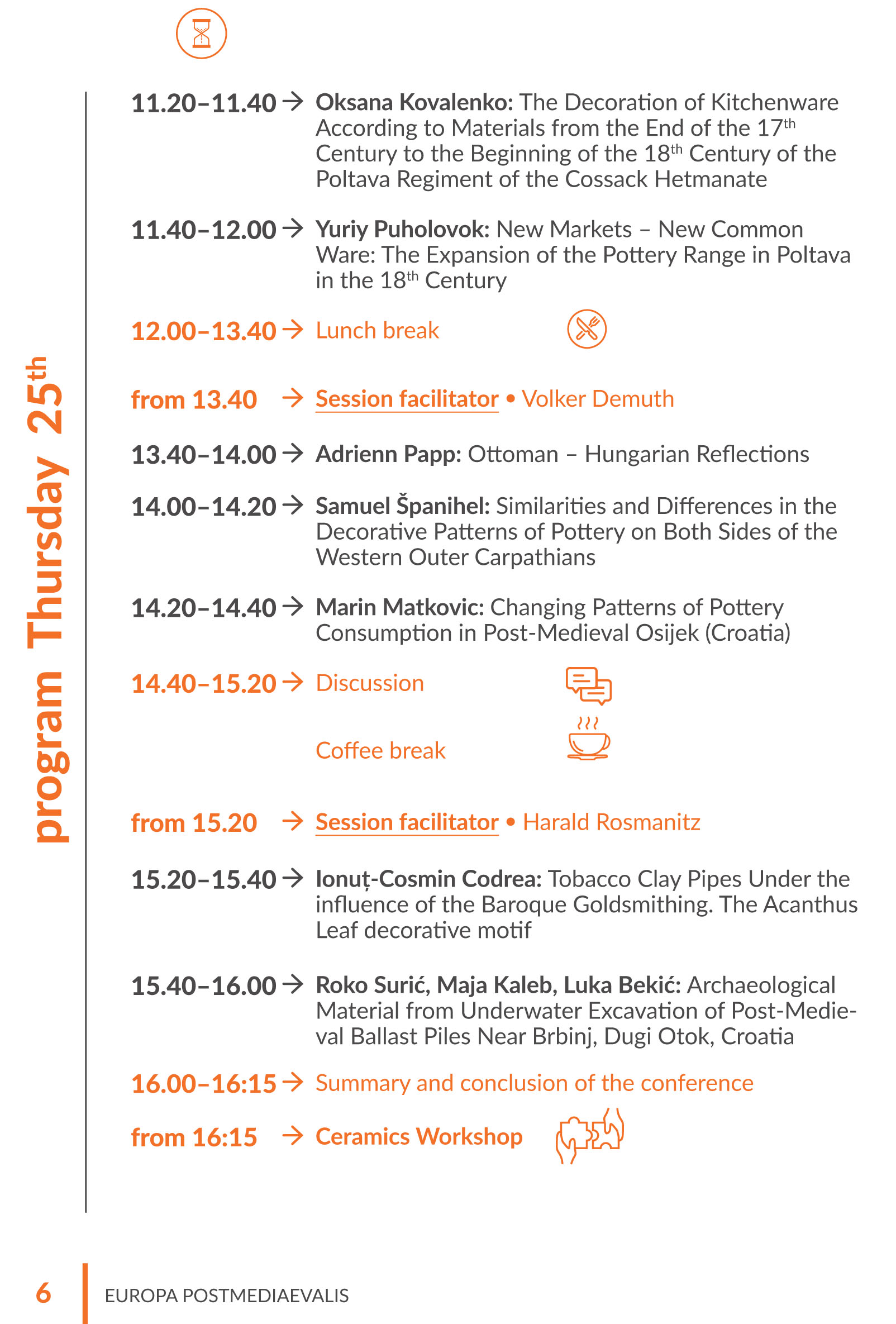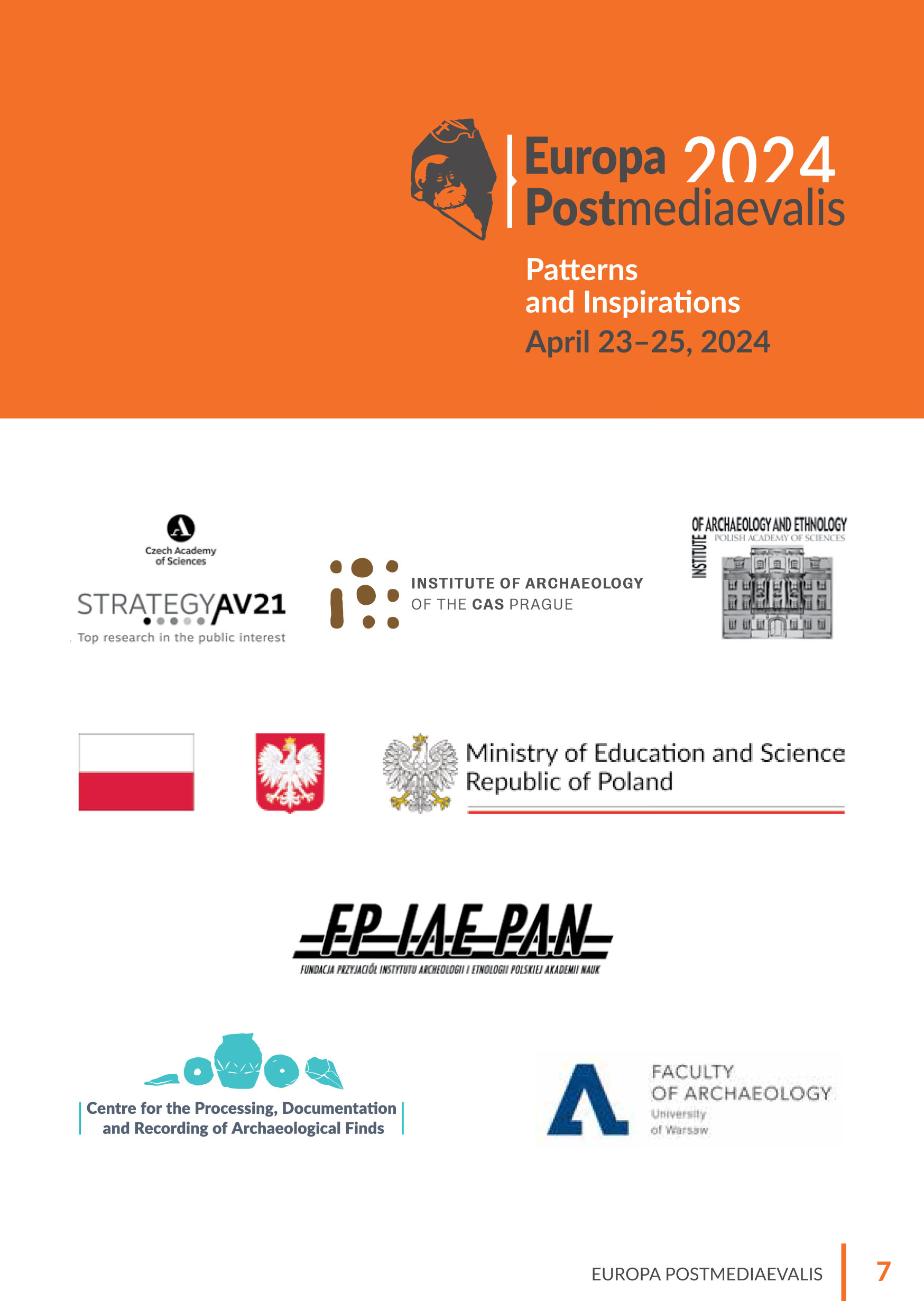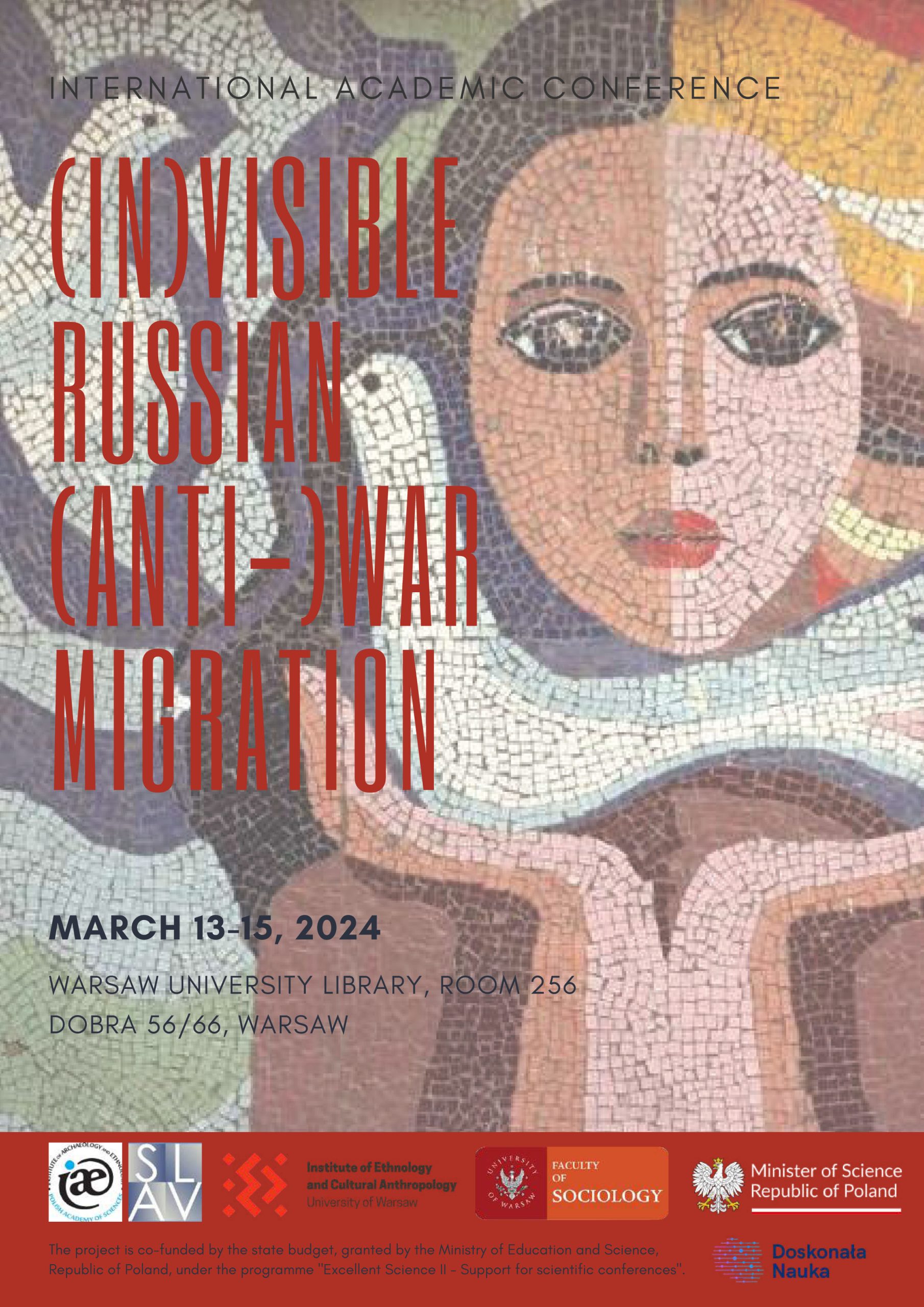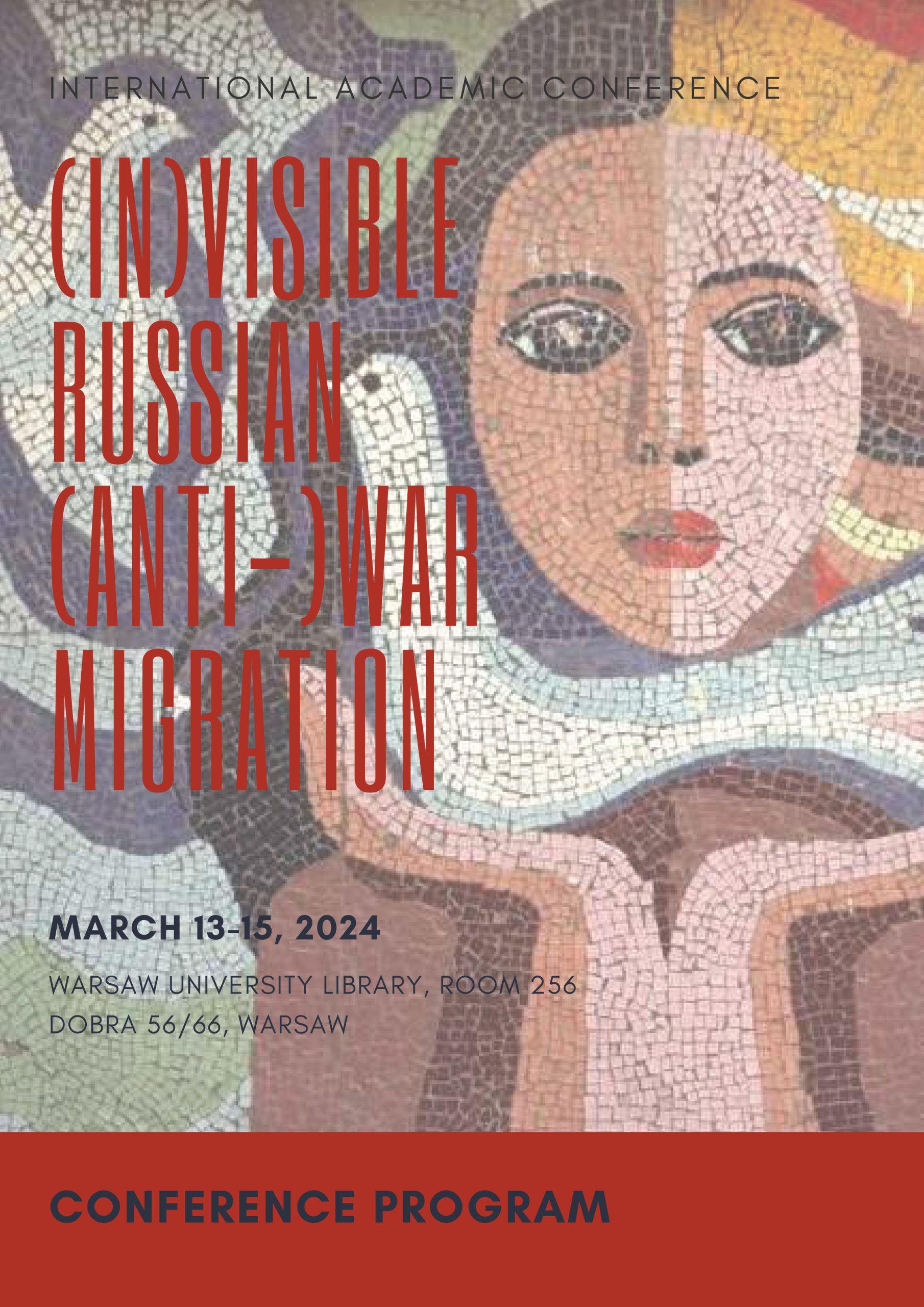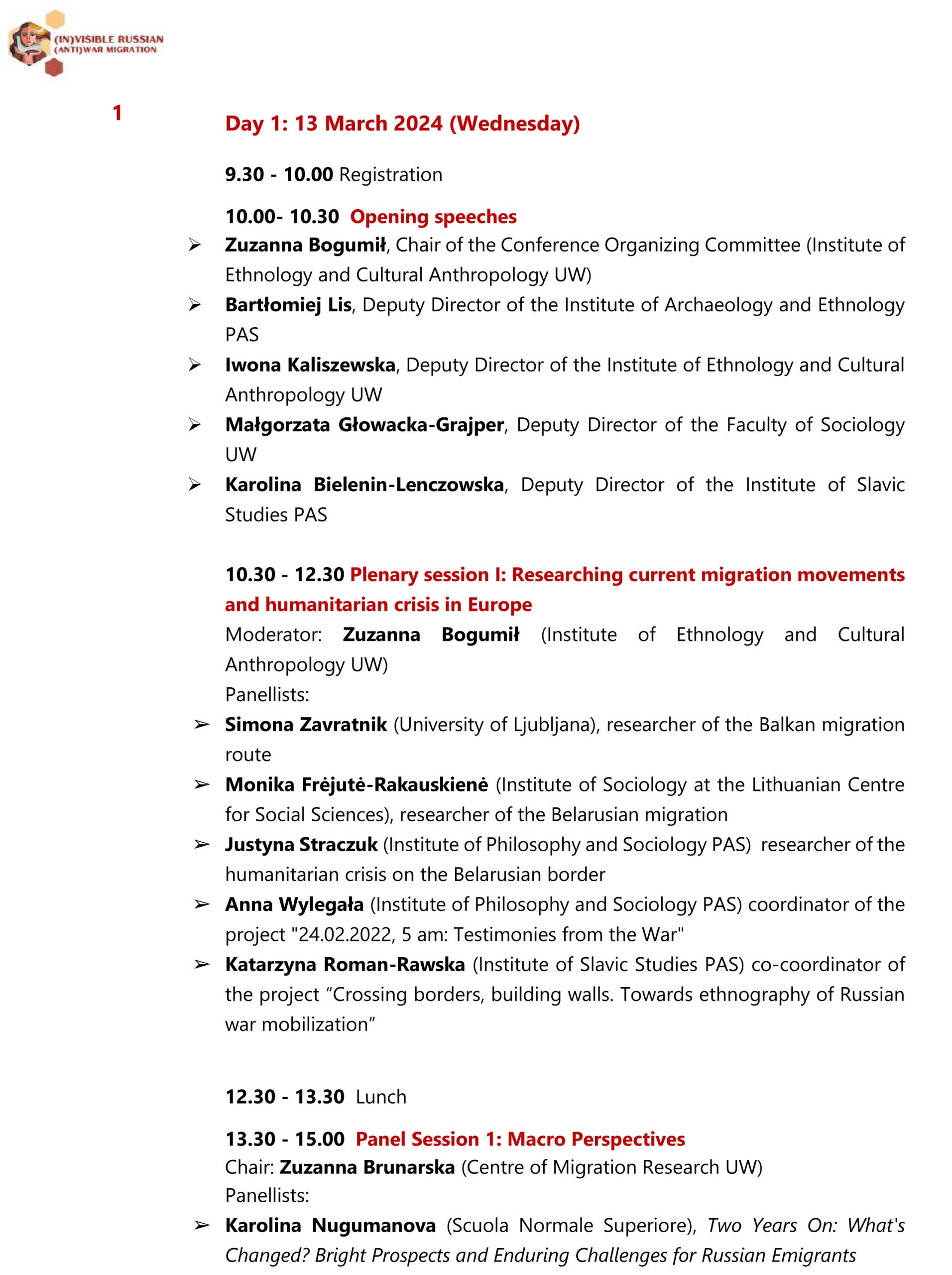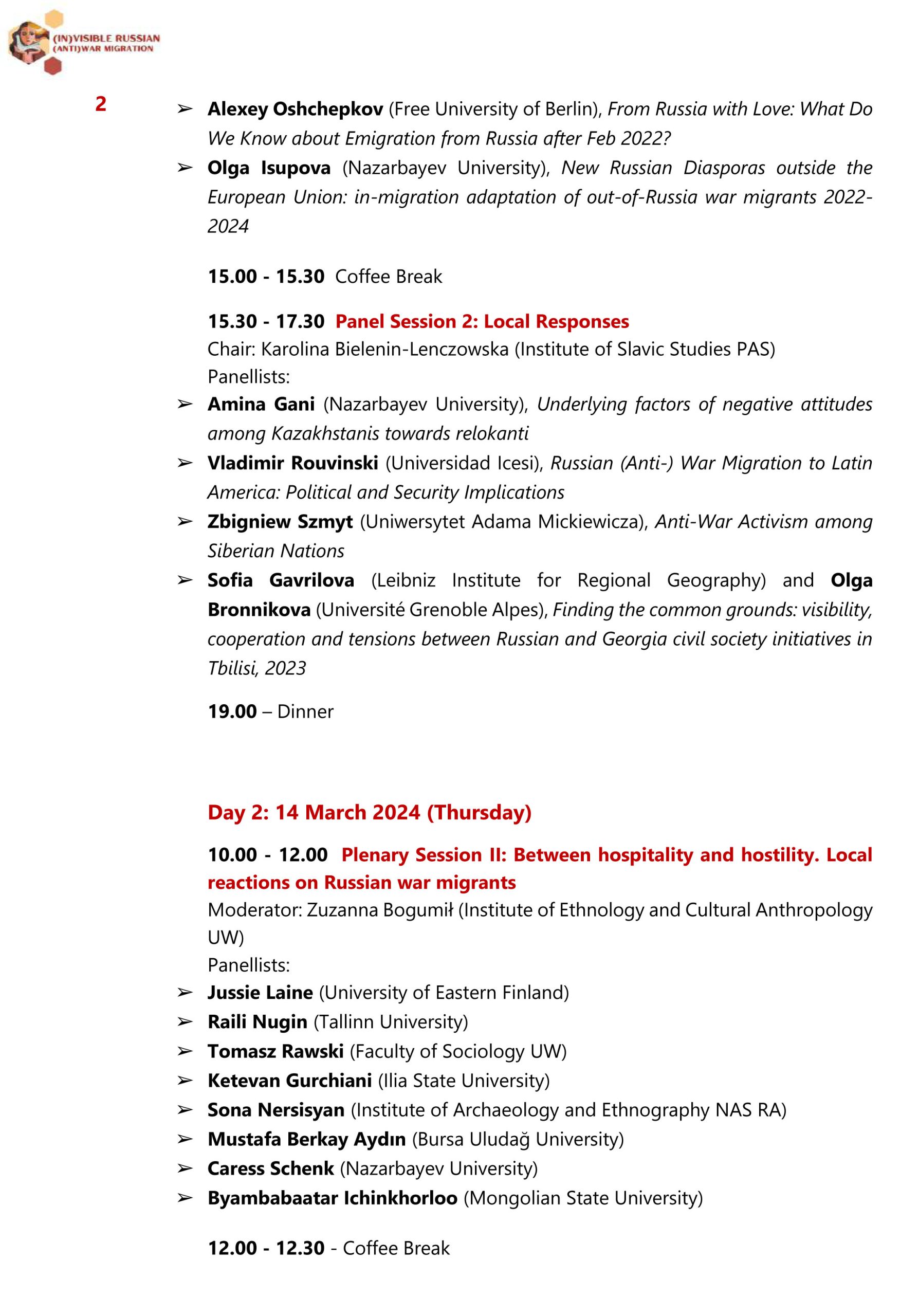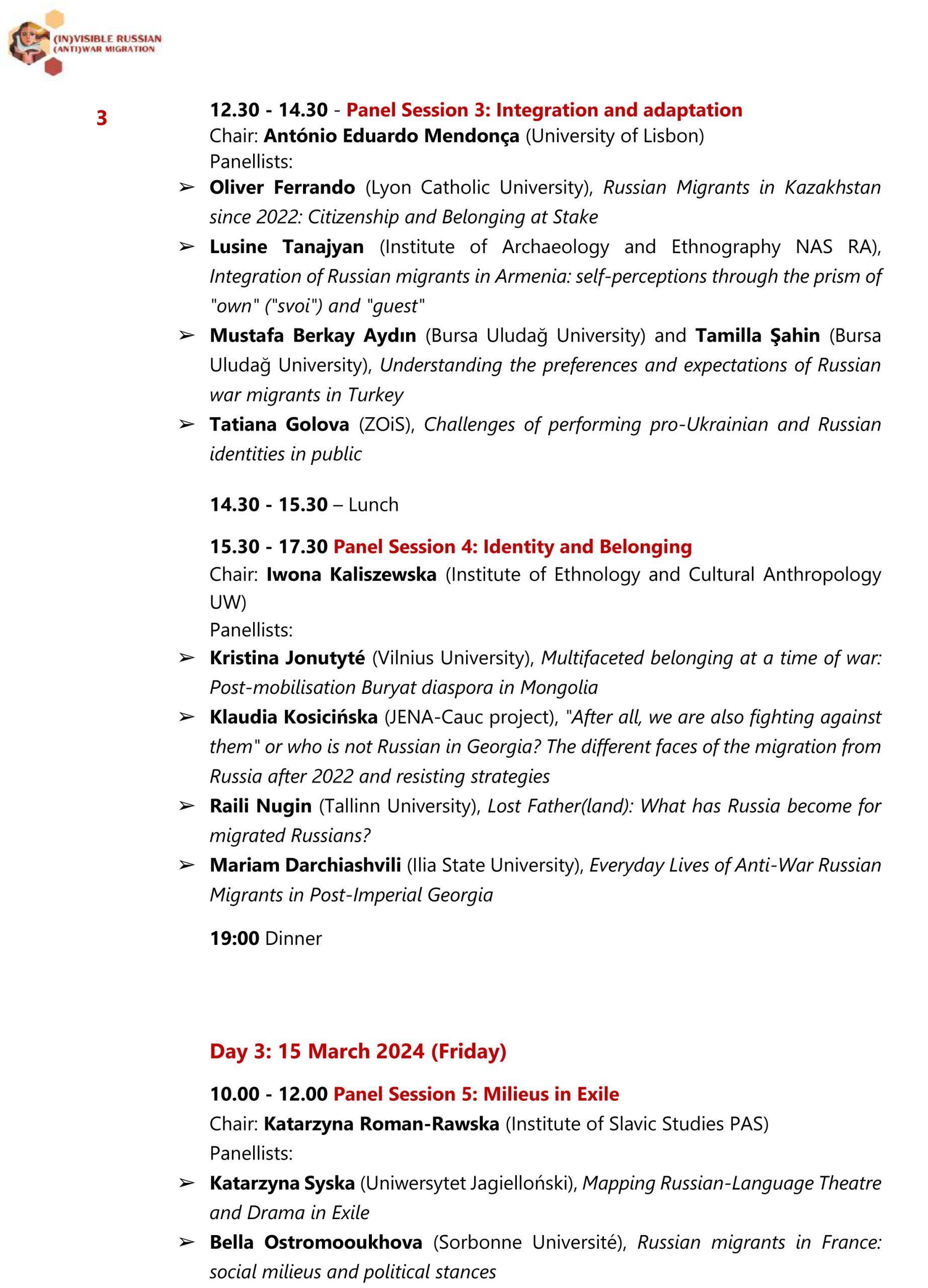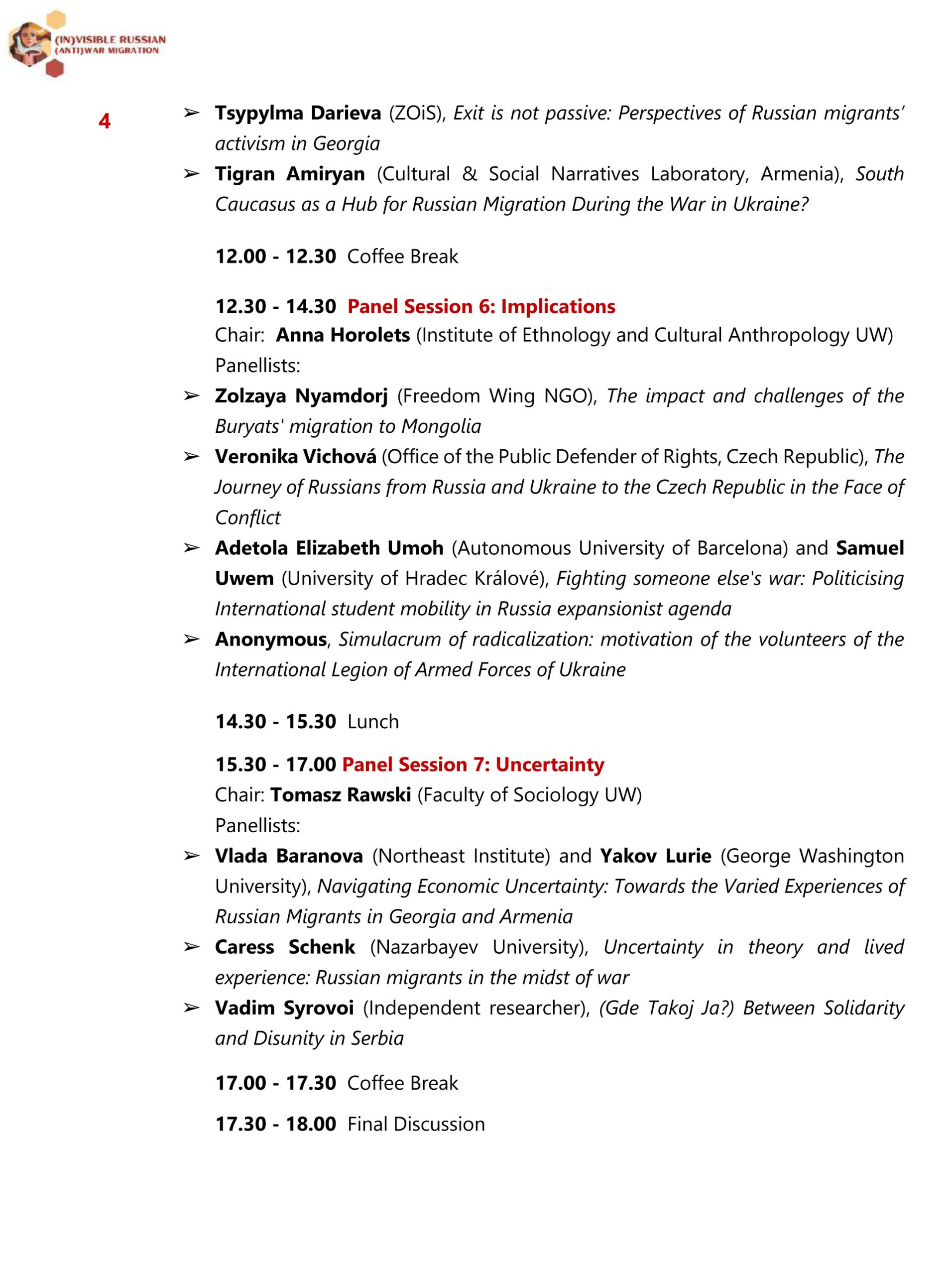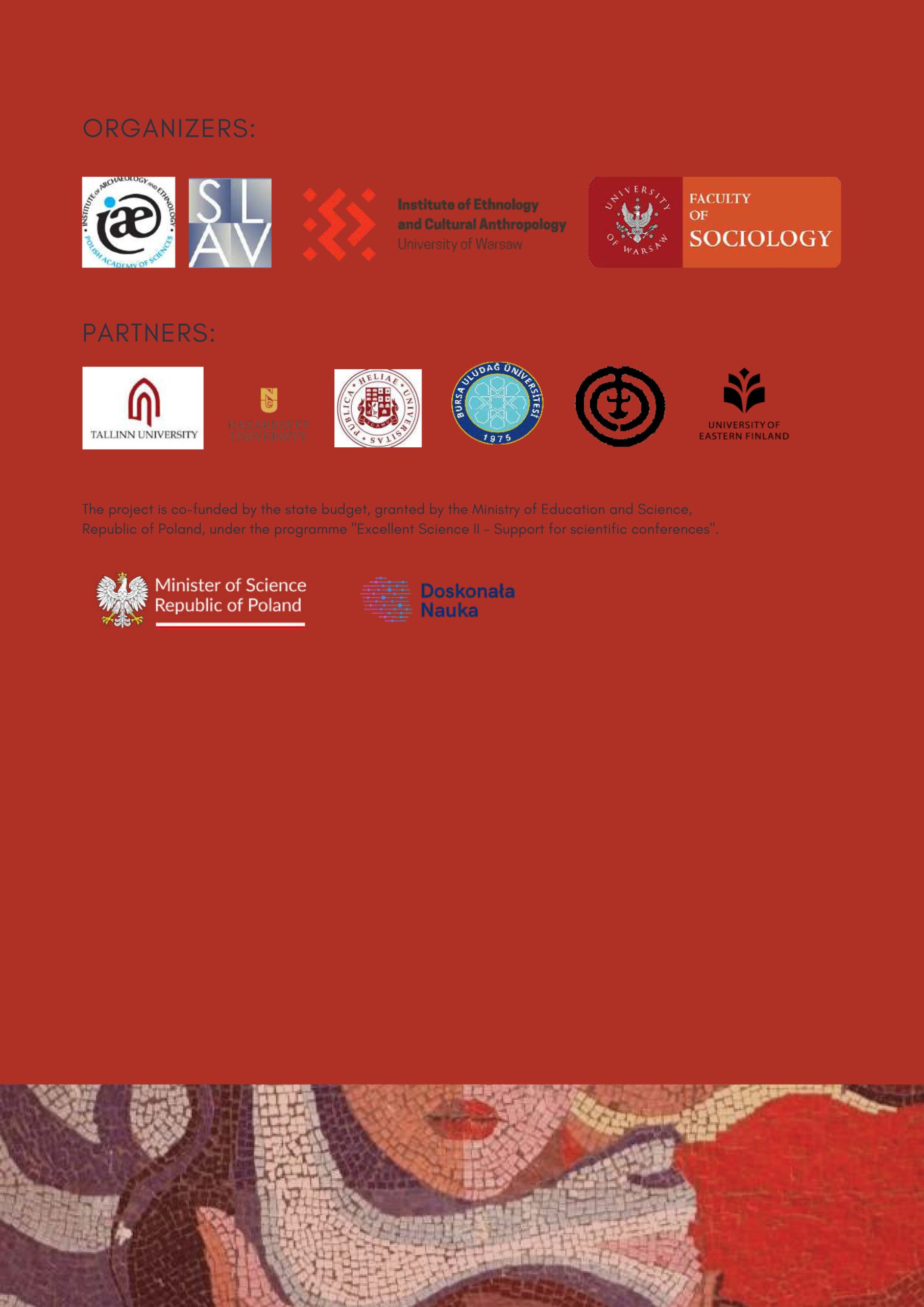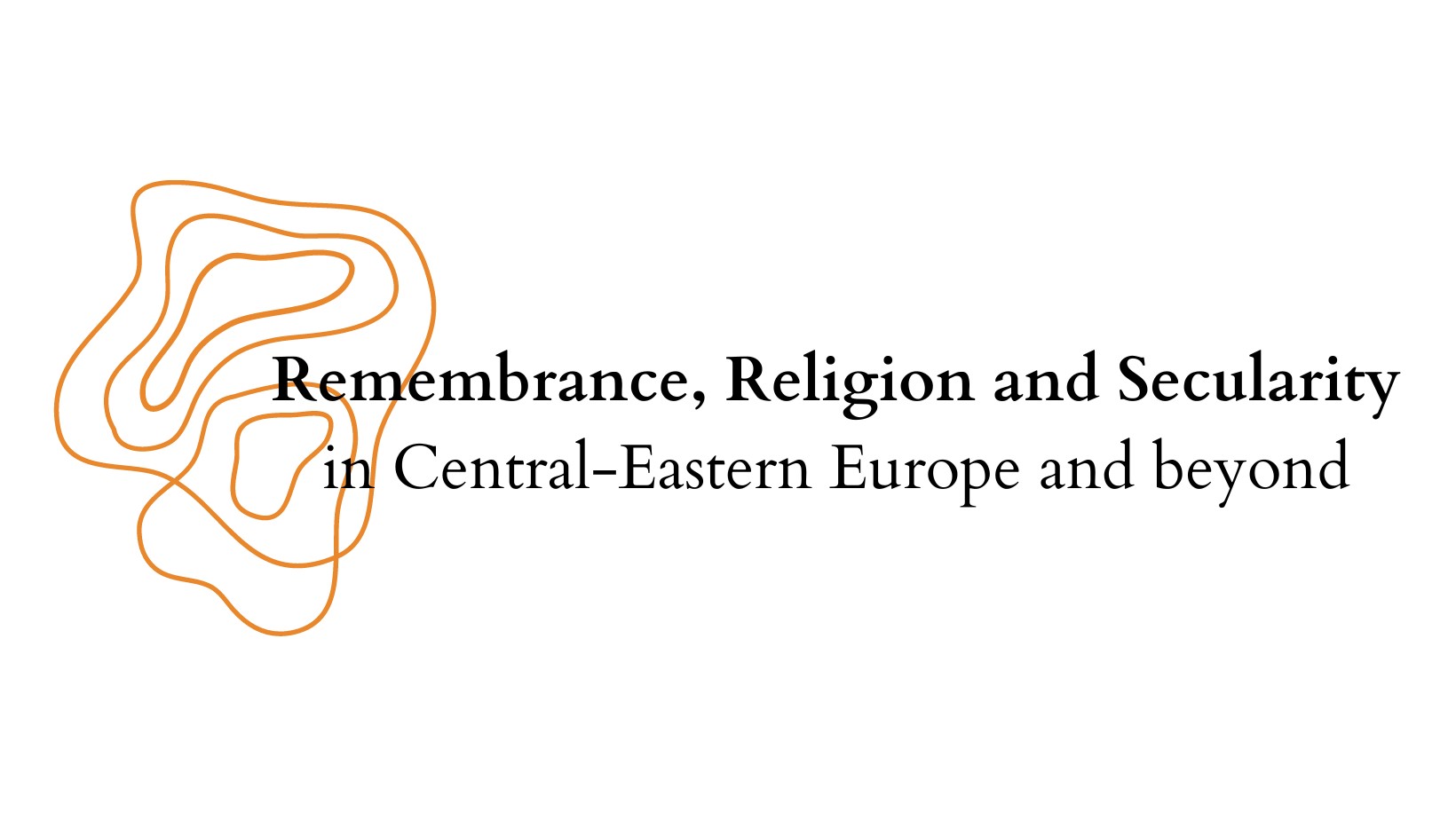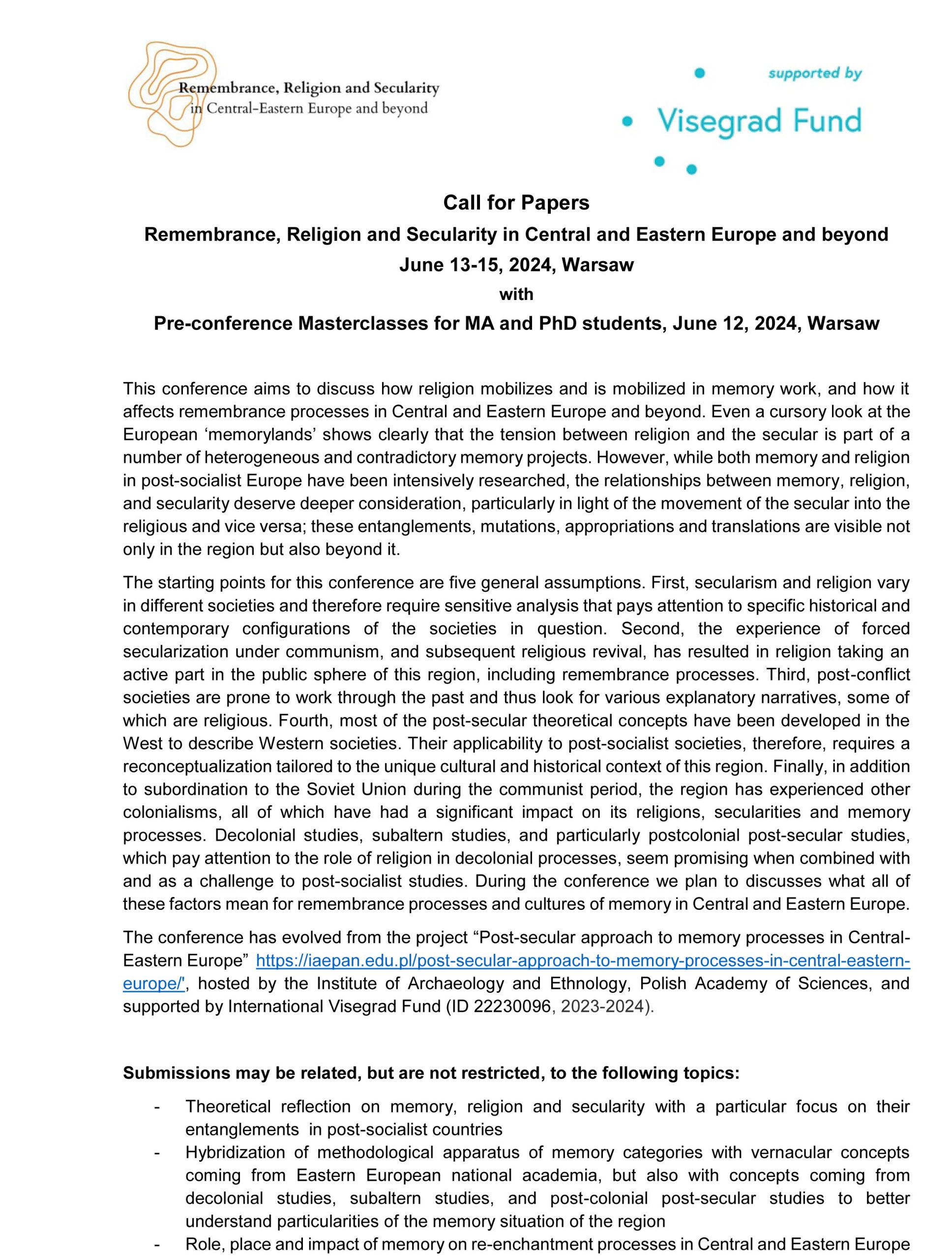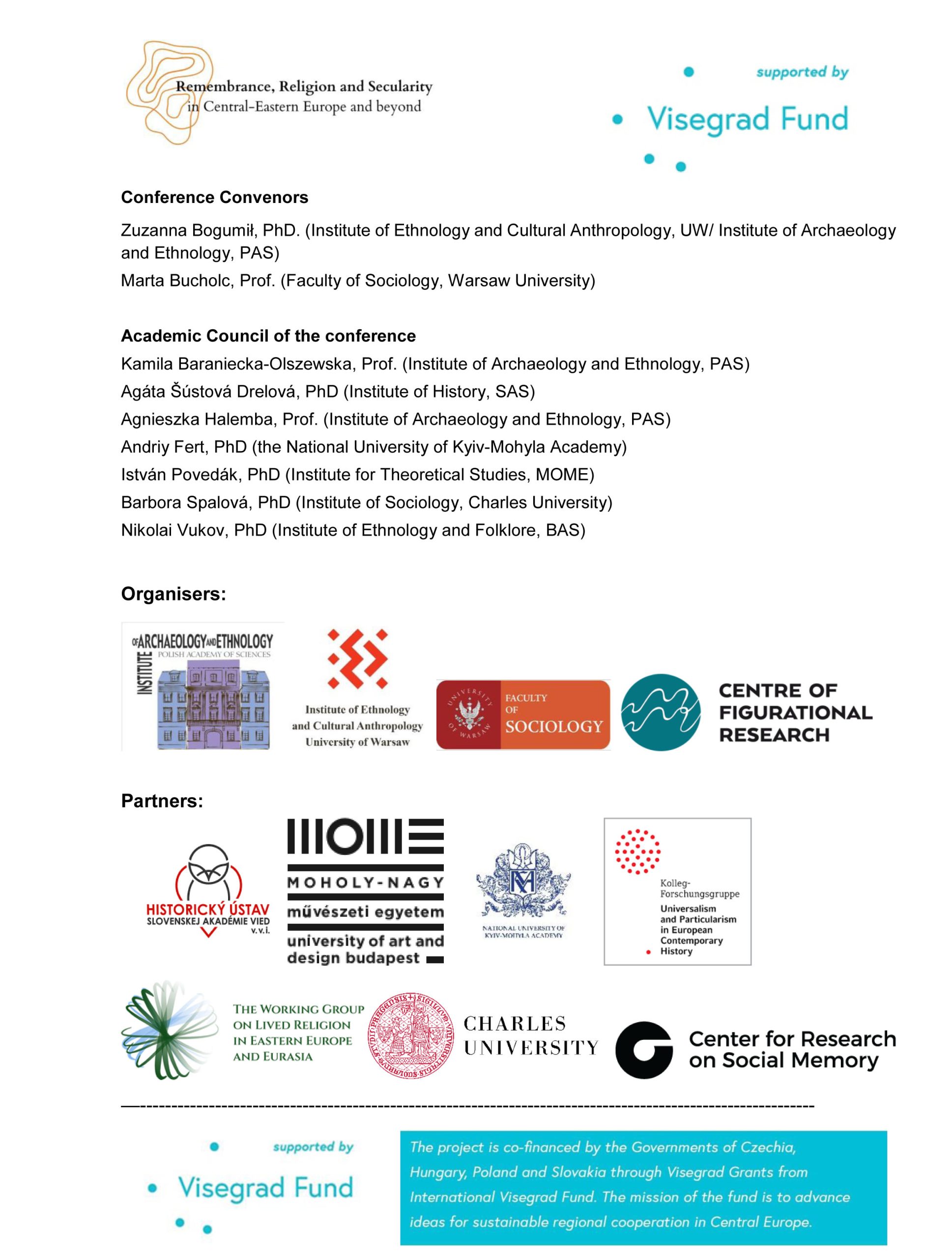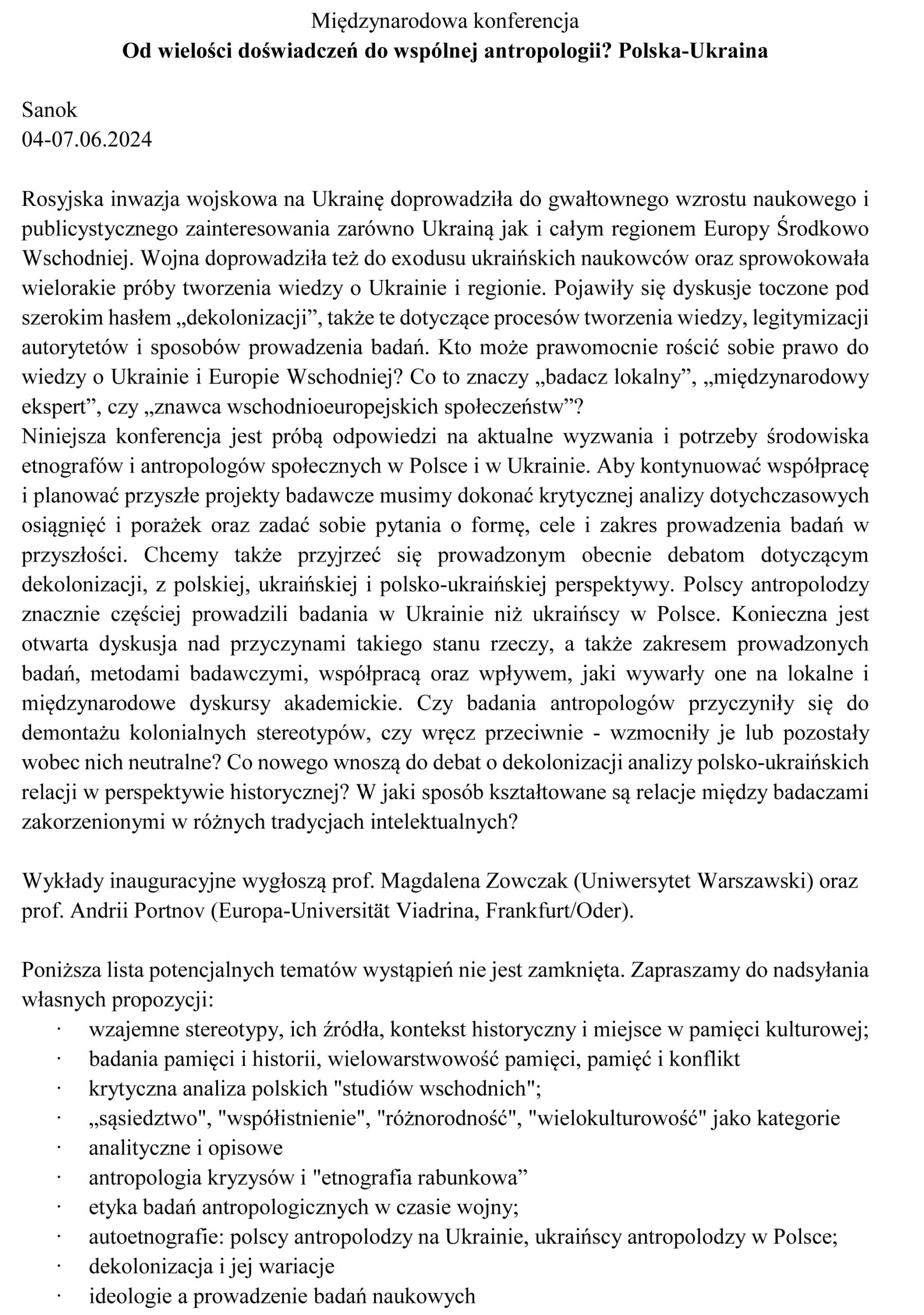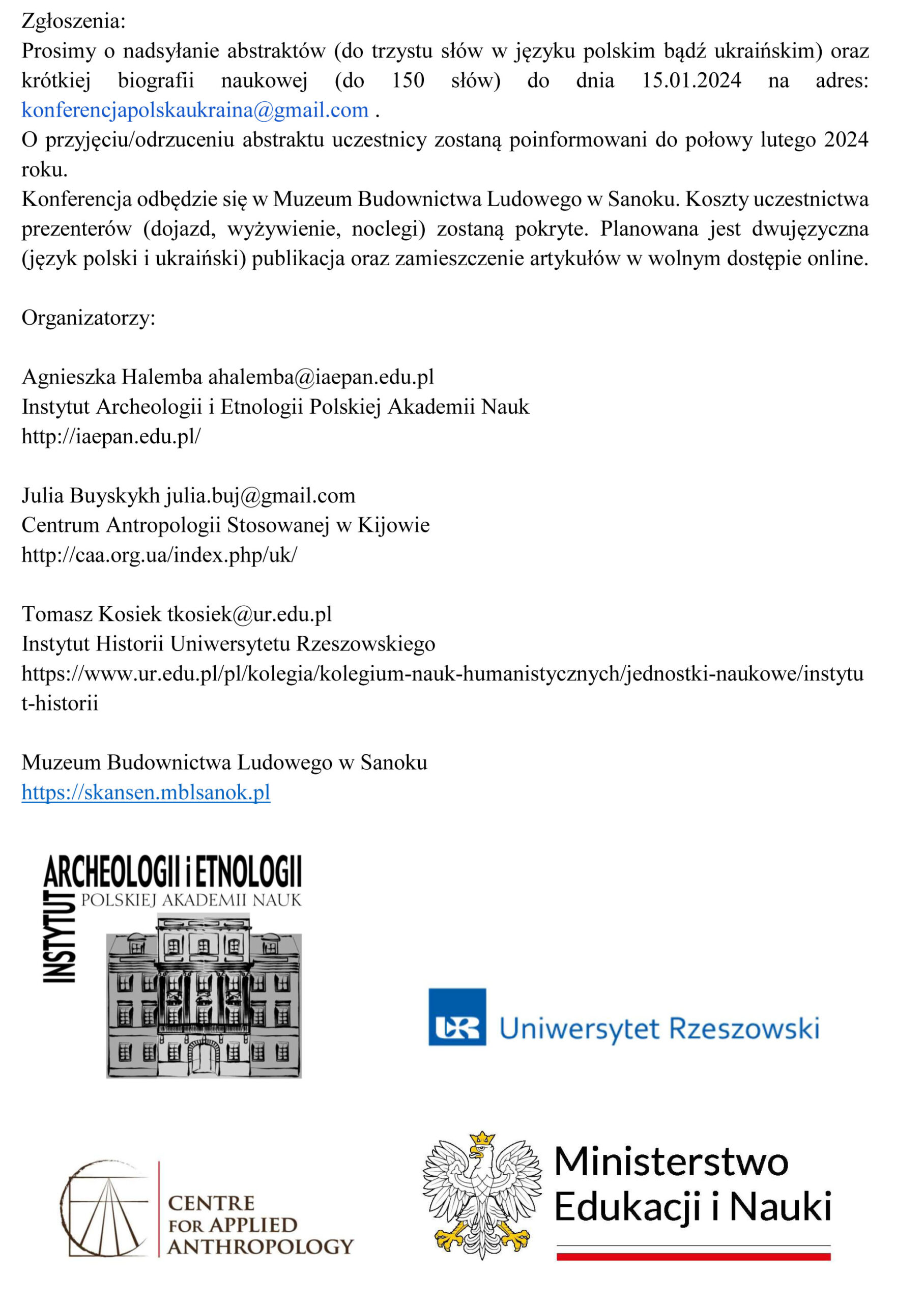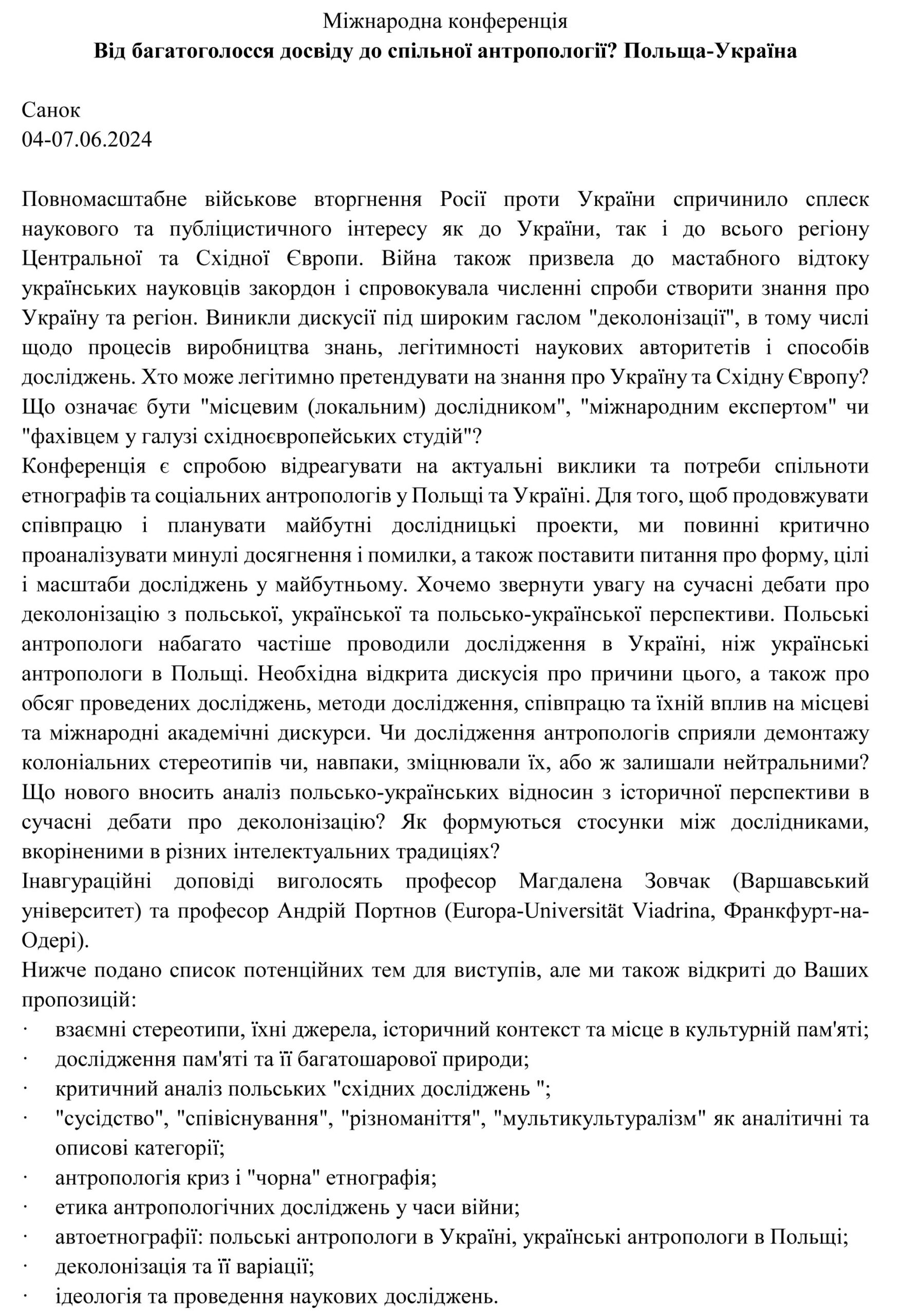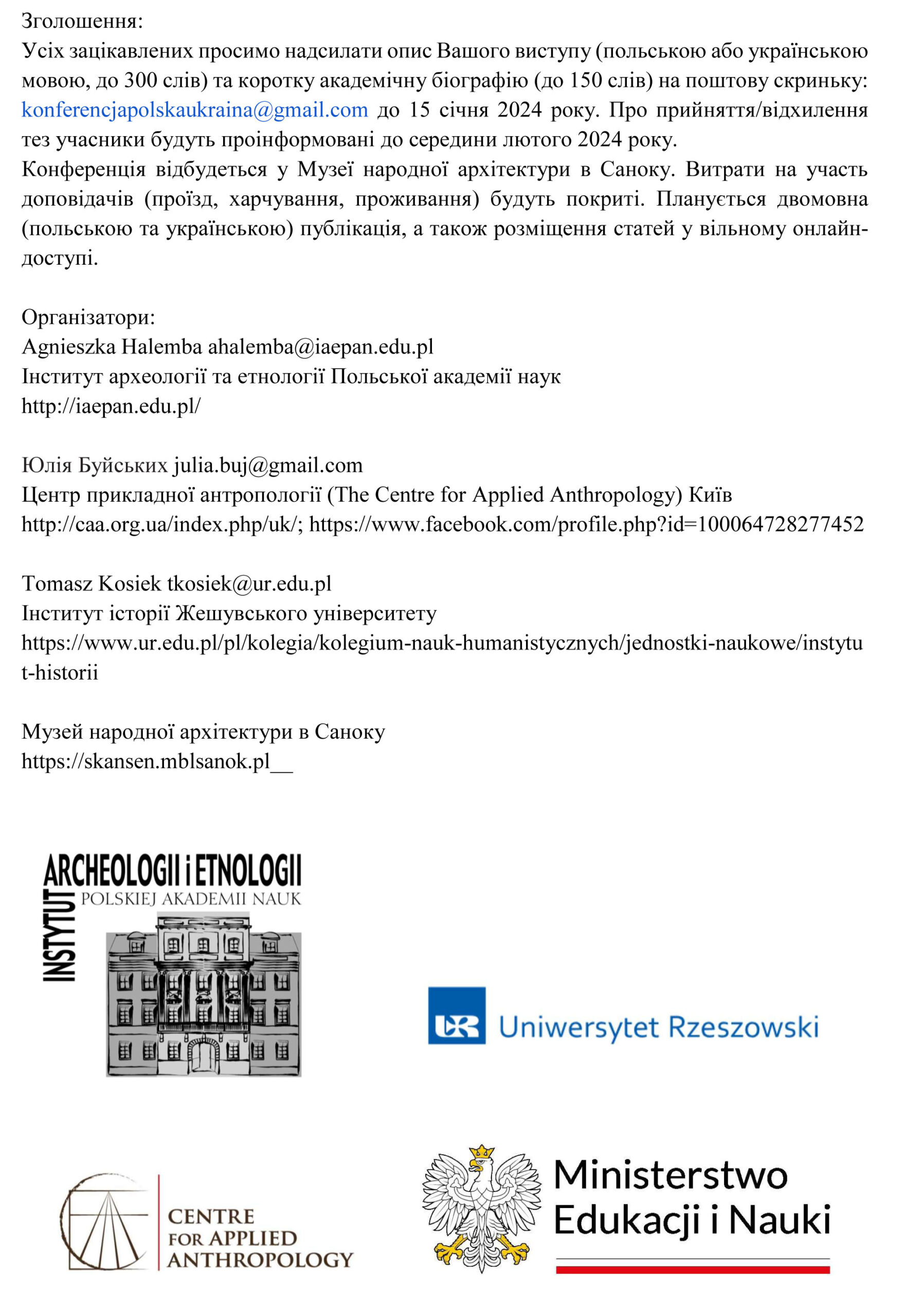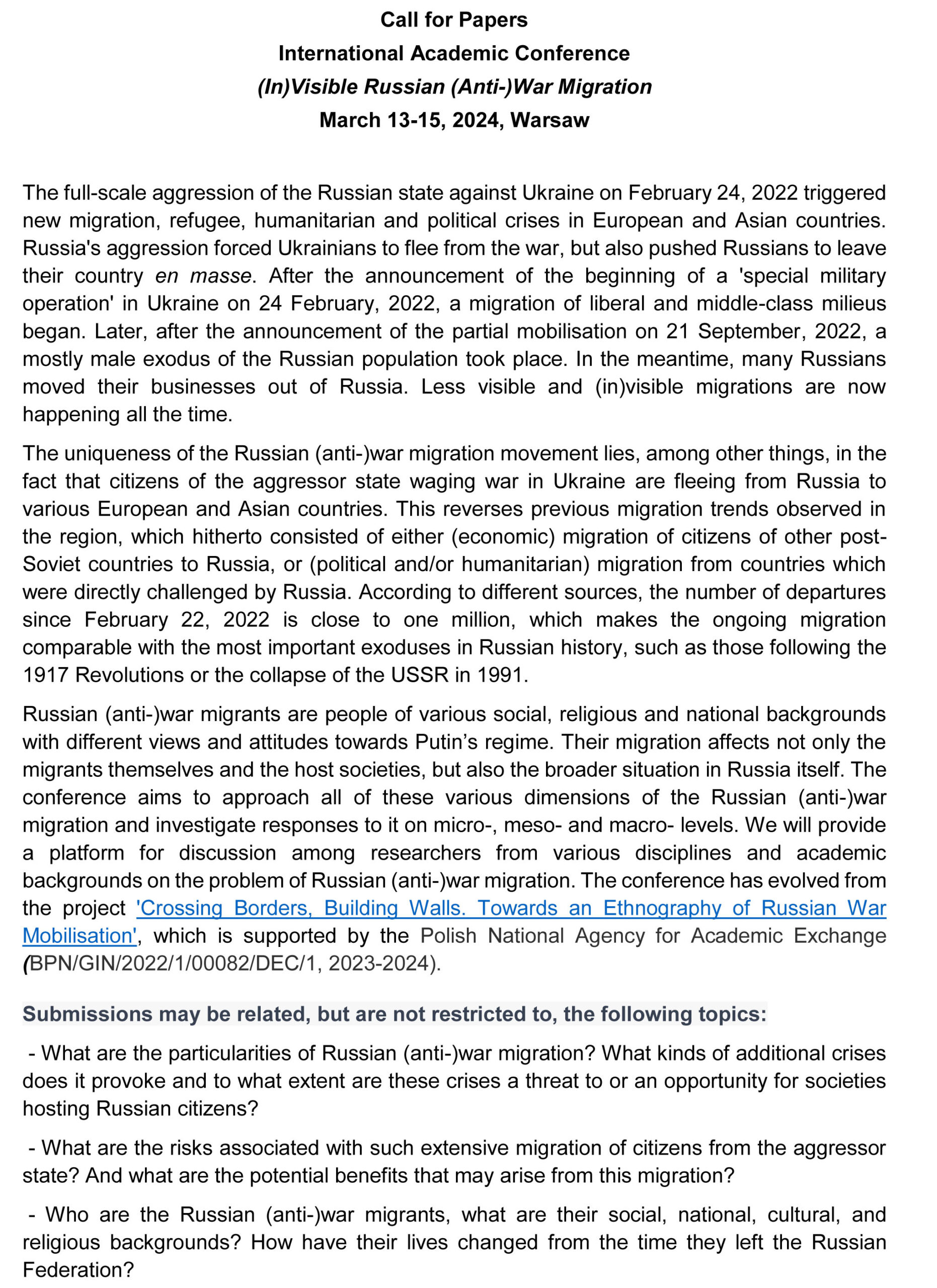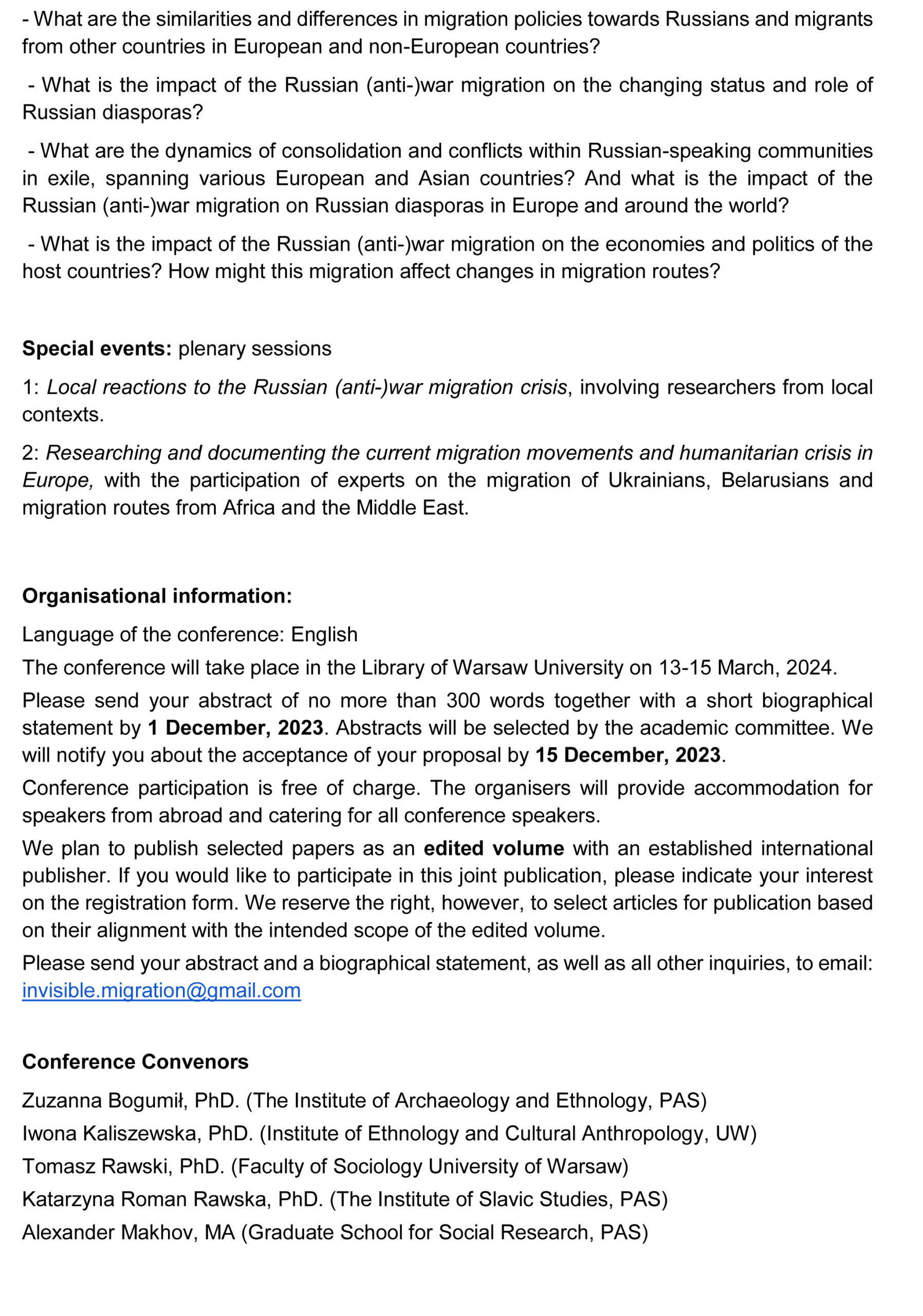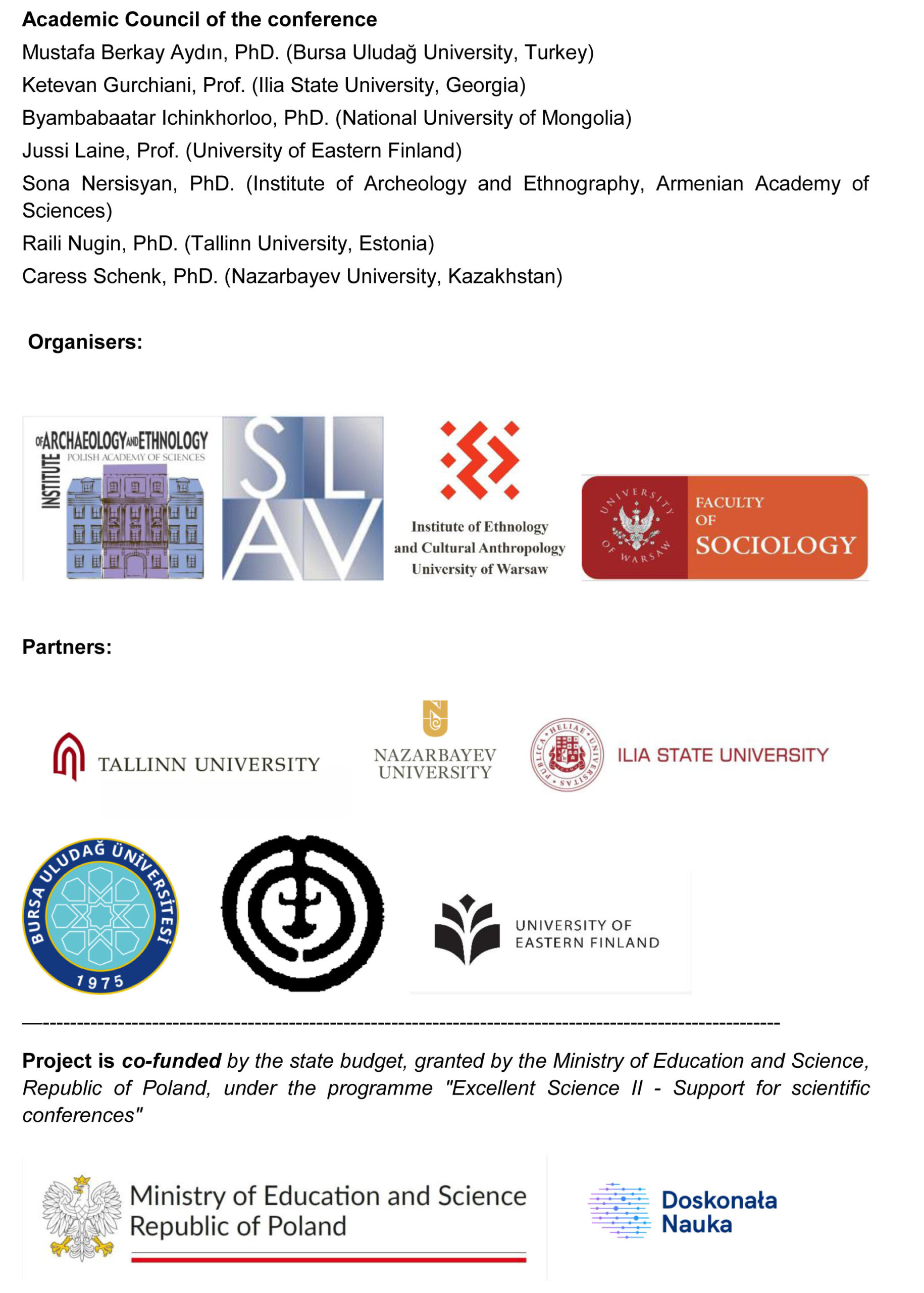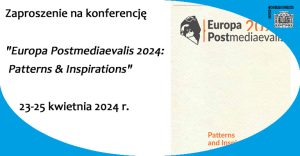
Zaproszenie na konferencję "Europa Postmediaevalis 2024: Patterns & Inspirations" on-line - 23-25 kwietnia 2024 r.
18 kwietnia 2024
Nataliacoments closed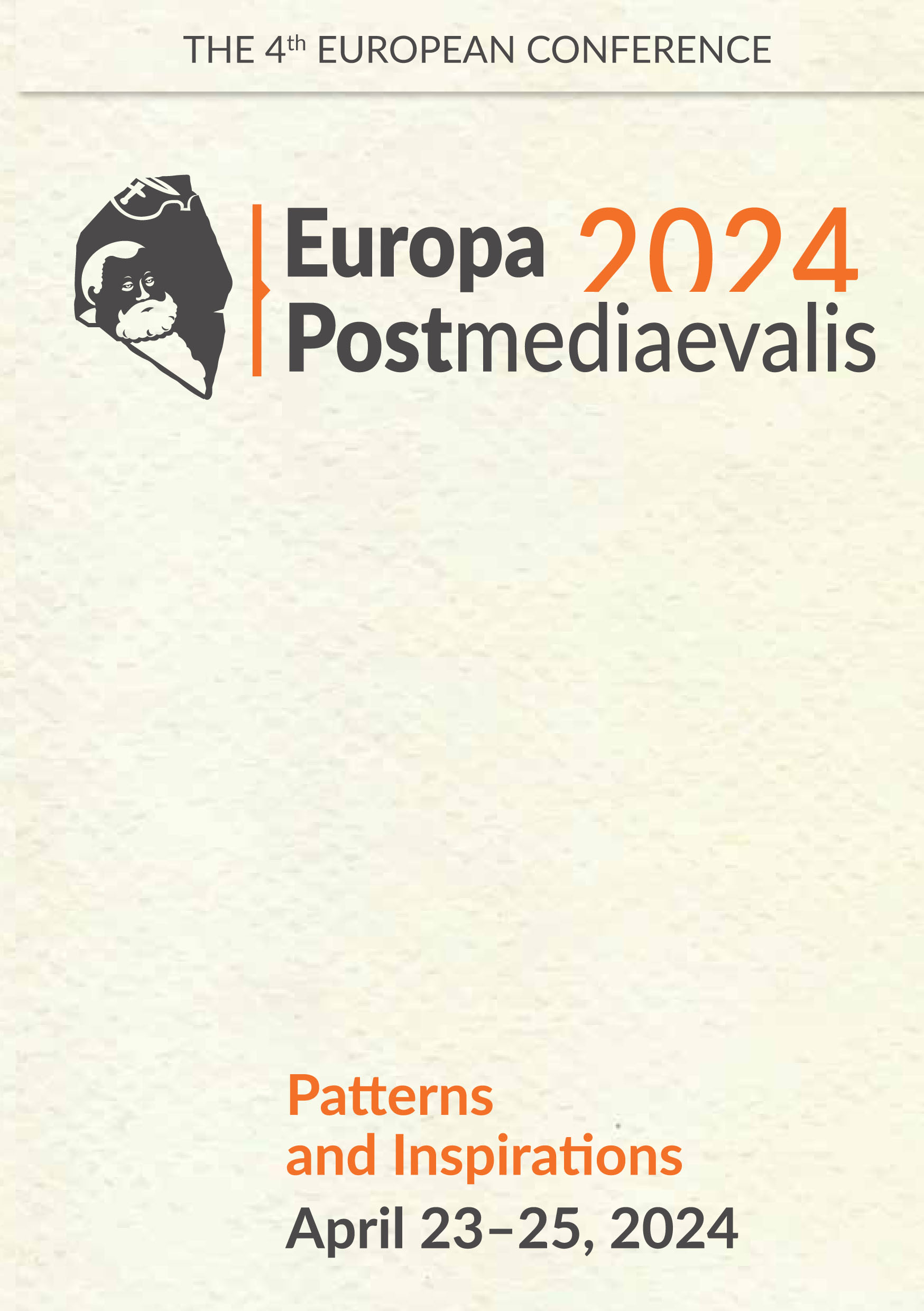

Zaproszenie na konferencję naukową Ośrodka Archeologii Pradziejowej i Ośrodka Archeologii Historycznej IAE PAN - 18 kwietnia 2024 r., godz.11.00
10 kwietnia 2024
Nataliacoments closed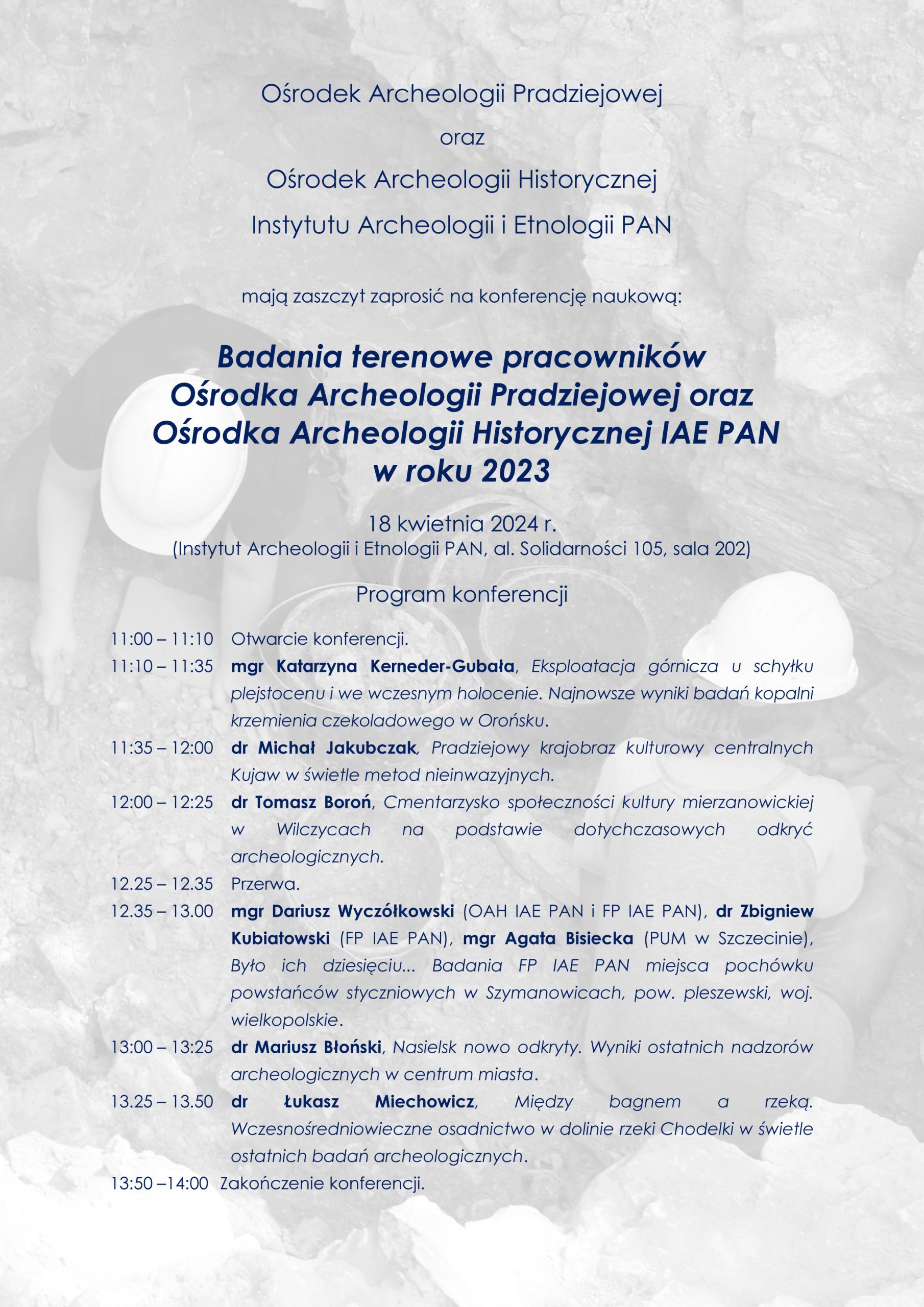
Serdecznie zapraszamy na konferencję naukową:
Badania terenowe pracowników Ośrodka Archeologii Pradziejowej oraz Ośrodka Archeologii Historycznej IAE PAN w roku 2023,
która odbędzie się 18 kwietnia 2024 r. w Instytucie Archeologii i Etnologii PAN, al. Solidarności 105, sala 202. Początek zebrania o godz. 11.00.
Referatów będzie też można wysłuchać za pomocą MSTeams:

Zaproszenie na konferencję "Europa Postmediaevalis 2024: Patterns & Inspirations" - 23-25 kwietnia 2024 r.
22 marca 2024
Nataliacoments closedZapraszamy do udziału w międzynarodowej konferencji naukowej poświęconej ceramice nowożytnej
"Europa Postmediaevalis 2024: Patterns & Inspirations",
która odbędzie się w dniach 23-25.04.2024 r. w Warszawie,
w Instytucie Archeologii i Etnologii PAN (23 i 24.04)
oraz na Wydziale Archeologii UW (25.04. b.r.).
Obrady będą transmitowane on-line.
Zachęcamy do zapoznania się z programem.
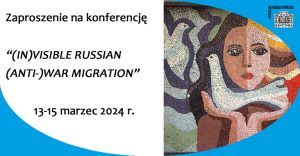
Zaproszenie na konferencję "(IN)VISIBLE RUSSIAN (ANTI-)WAR MIGRATION" - 13-15 marca 2024 r.
07 marca 2024
Nataliacoments closed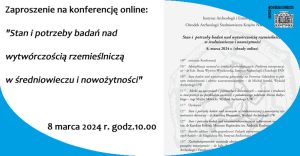
Zaproszenie na konferencję online: "Stan i potrzeby badań nad wytwórczością rzemieślniczą w średniowieczu i nowożytności" - 8 marca 2024 r. godz.10.00
27 lutego 2024
Nataliacoments closed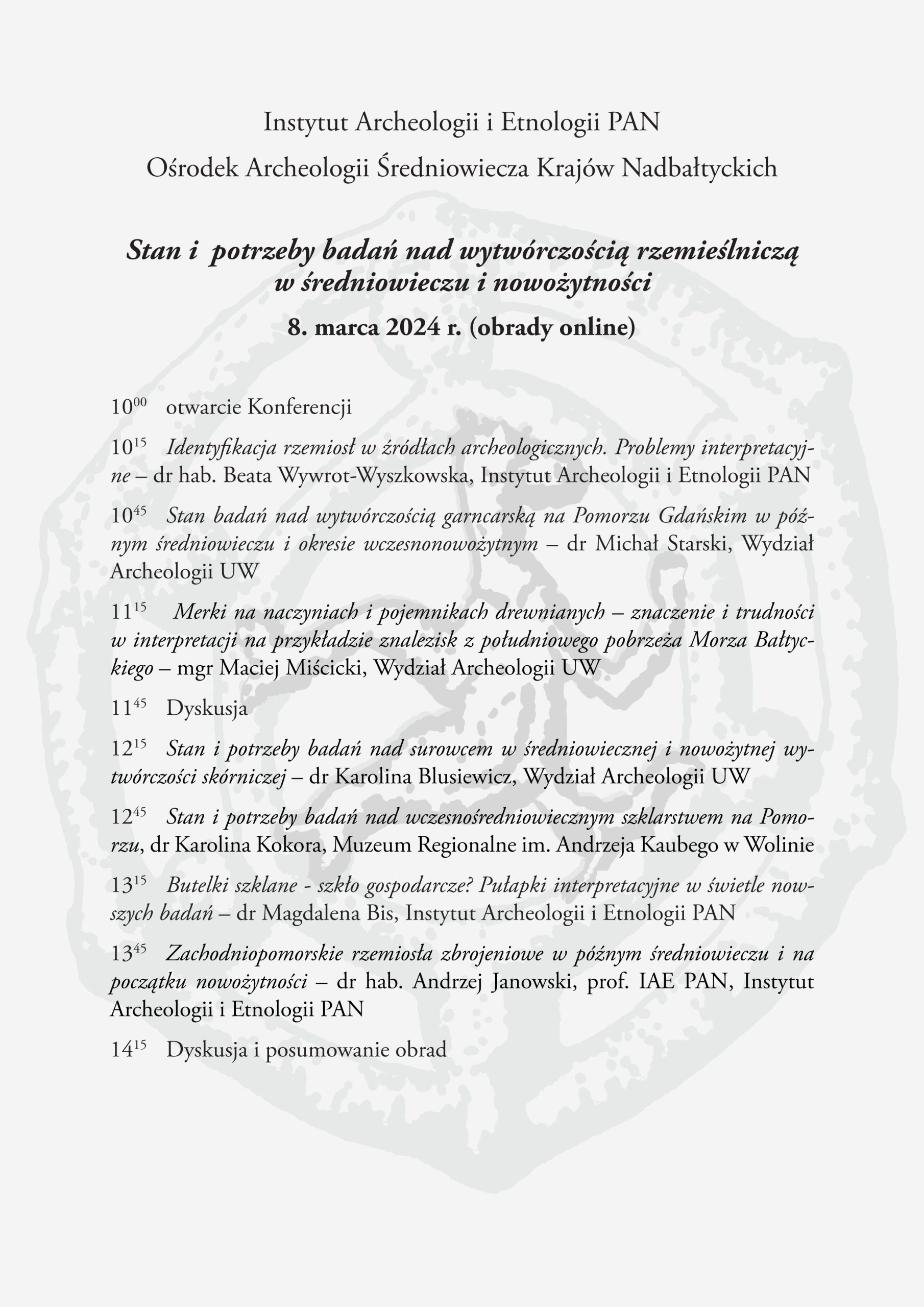
Ośrodek Archeologii Średniowiecza Krajów Nadbałtyckich IAE PAN
zaprasza do udziału w konferencji
"Stan i potrzeby badań nad wytwórczością rzemieślniczą w średniowieczu i nowożytności",
która odbędzie się 8. marca 2024,
w trybie online w godzinach 10-15
Link do spotkania: https://tiny.pl/dxc4v
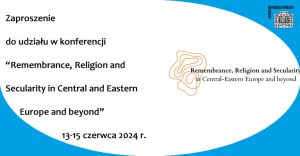
Zaproszenie do udziału w konferencji “Remembrance, Religion and Secularity in Central and Eastern Europe and beyond” - 13-15 czerwca 2024 r.
26 lutego 2024
Nataliacoments closedRemembrance, Religion and Secularity in Central and Eastern Europe and beyond
This conference aims to discuss how religion mobilizes and is mobilized in memory work, and how it affects remembrance processes in Central and Eastern Europe and beyond. Even a cursory look at the European ‘memorylands’ shows clearly that the tension between religion and the secular is part of a number of heterogeneous and contradictory memory projects. However, while both memory and religion in post-socialist Europe have been intensively researched, the relationships between memory, religion, and secularity deserve deeper consideration, particularly in light of the movement of the secular into the religious and vice versa; these entanglements, mutations, appropriations and translations are visible not only in the region but also beyond it.
The starting points for this conference are five general assumptions. First, secularism and religion vary in different societies and therefore require sensitive analysis that pays attention to specific historical and contemporary configurations of the societies in question. Second, the experience of forced secularization under communism, and subsequent religious revival, has resulted in religion taking an active part in the public sphere of this region, including remembrance processes. Third, post-conflict societies are prone to work through the past and thus look for various explanatory narratives, some of which are religious. Fourth, most of the post-secular theoretical concepts have been developed in the West to describe Western societies. Their applicability to post-socialist societies, therefore, requires a reconceptualization tailored to the unique cultural and historical context of this region. Finally, in addition to subordination to the Soviet Union during the communist period, the region has experienced other colonialisms, all of which have had a significant impact on its religions, secularities and memory processes. Decolonial studies, subaltern studies, and particularly postcolonial post-secular studies, which pay attention to the role of religion in decolonial processes, seem promising when combined with and as a challenge to post-socialist studies. During the conference we plan to discusses what all of these factors mean for remembrance processes and cultures of memory in Central and Eastern Europe.
The conference has evolved from the project “Post-secular approach to memory processes in Central-Eastern Europe” https://iaepan.edu.pl/post-secular-approach-to-memory.../', hosted by the Institute of Archaeology and Ethnology, Polish Academy of Sciences, and supported by International Visegrad Fund (ID 22230096, 2023-2024).
- Theoretical reflection on memory, religion and secularity with a particular focus on their entanglements in post-socialist countries
- Hybridization of methodological apparatus of memory categories with vernacular concepts coming from Eastern European national academia, but also with concepts coming from decolonial studies, subaltern studies, and post-colonial post-secular studies to better understand particularities of the memory situation of the region
- Role, place and impact of memory on re-enchantment processes in Central and Eastern Europe
- Specificities of the religious and secular narratives on the past, their entanglements, mutations and appropriations
- Influence of Churches and other religious organizations and their interpretations of the past on the remembrance processes and cultures of memory
- Implications of mixing religious and secular symbols and memory rituals in the ‘memorylands’
- Post-secular aspects of religion and their impact on commemorative practices
- Impact of tensions provoked by memory, religion and secularity entanglements for the local and global memory cultures
- In-depth analysis of selected case studies, which discuss different religion actualizations in memory processes in Central and Eastern Europe
1: Plenary sessions: Memory and Post-secularism – Jose Casanova (Georgetown University, USA), Manav Ratti (Salisbury University, USA) and Stanislav Obirek (The American Studies Center, UW)
2: Plenary session: Memory and Religion in Central and Eastern Europe - Tatiana Zachar Podolinská (Institute of Ethnology and Social Anthropology, SAS), Małgorzata Głowacka-Grajper (Faculty of Sociology, Warsaw University), Csaba Szaló (Masaryk University), Andreas Máté Toth (University of Szeged), Liliya Berezhnaya (Central European University).
Pre-conference Master Classes (June 12, 2024)
This one-day intensive masterclass is designed for MA and PhD students from the Visegrad region to discuss their ongoing work on remembrance, memory and religion in Central and Eastern Europe. Students will present their research to their peers and instructors and gain detailed feedback from experts in the field on their work. Attendees of the masterclass also participate in the conference and all special events.
Language: English
To attend the conference
Please send your abstract of no more than 300 words together with a short biographical statement by March 30, 2024. Abstracts will be selected by the academic committee. We will notify you about the acceptance of your proposal by April 15, 2024. Conference participation is free of charge. The organizers do not provide accommodation and transportation for conference participants. But, it is possible to participate in the conference online.
To attend the pre-conference masterclasses
Please send your extended abstract of 2000 words together with a short biographical statement by March 30, 2024. Abstracts will be selected by the academic committee. We will notify you about the acceptance of your proposal by April 15, 2024. You will be expected to send your final papers by May 15, 2024. The masterclasses have only in person form. Organizers will cover travel expenses and accommodation in a hostel in Warsaw for the duration of the conference.
Zuzanna Bogumił, PhD. (Institute of Ethnology and Cultural Anthropology, UW/ Institute of Archaeology and Ethnology, PAS)
Marta Bucholc, Prof. (Faculty of Sociology, Warsaw University)
Academic Council of the conference
Kamila Baraniecka-Olszewska, Prof. (Institute of Archaeology and Ethnology, PAS)
Agáta Šústová Drelová, PhD (Institute of History, SAS)
Agnieszka Halemba, Prof. (Institute of Archaeology and Ethnology, PAS)
Andriy Fert, PhD (the National University of Kyiv-Mohyla Academy)
István Povedák, PhD (Institute for Theoretical Studies, MOME)
Barbora Spalová, PhD (Institute of Sociology, Charles University)
Nikolai Vukov, PhD (Institute of Ethnology and Folklore, BAS)
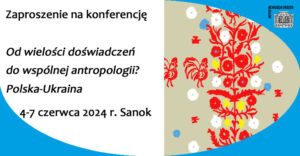
Zaproszenie na konferencję "Od wielości doświadczeń do wspólnej antropologii? Polska-Ukraina" - 4-7 czerwca 2024 r. Sanok
12 grudnia 2023
Nataliacoments closed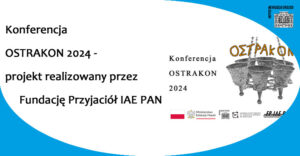
Konferencja OSTRAKON 2024 - projekt realizowany przez Fundację Przyjaciół Instytutu Archeologii i Etnologii PAN
23 października 2023
Nataliacoments closed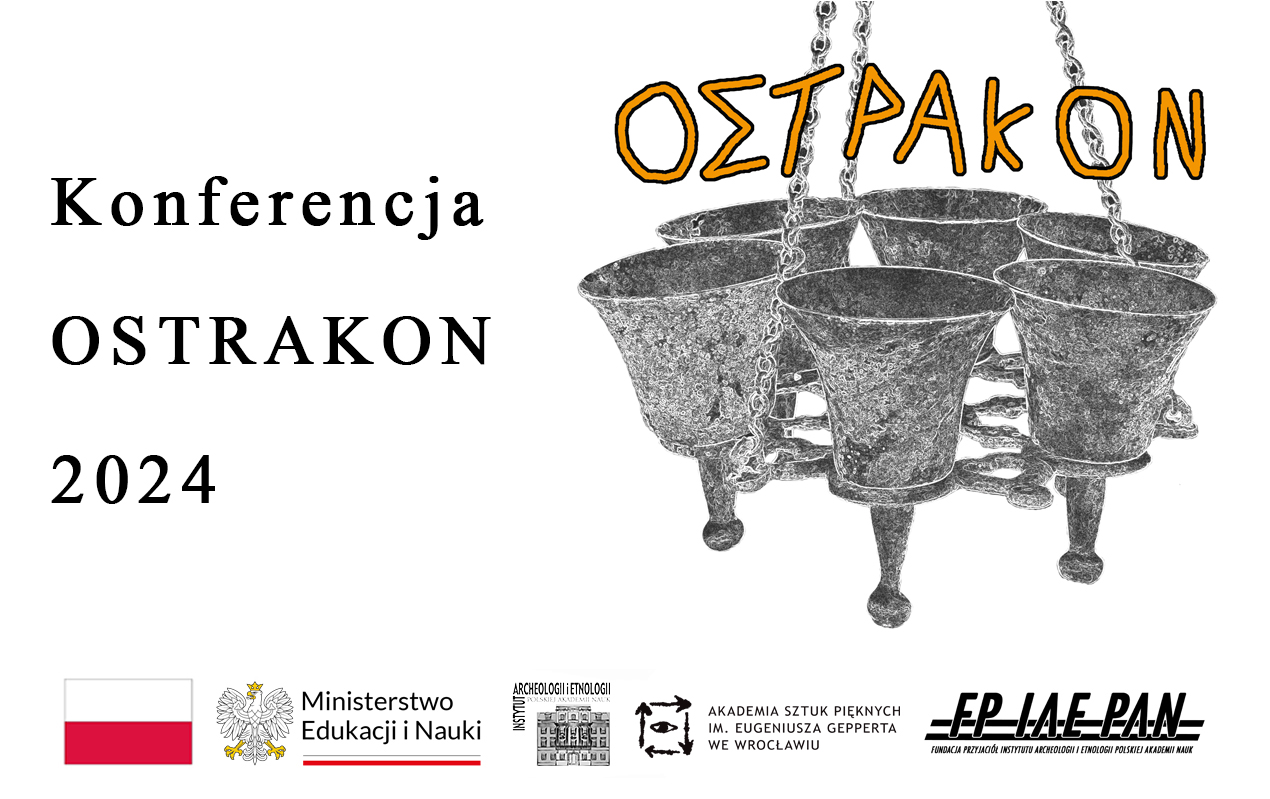
W dniach 12-14 czerwca 2024 roku, w Centrum Sztuk Użytkowych i Centrum Innowacyjności wrocławskiej ASP im. E. Gepperta oraz w Ośrodku Badań nad Kulturą Późnego Antyku i Wczesnego Średniowiecza IAE PAN, planowane jest Szóste Międzynarodowe Sympozjum Ceramiki i Szkła OSTRAKON. Tym razem będzie ono przebiegać pod hasłem: „Ceramika i Szkło w relacjach interkulturowych”.
Celem konferencji jest skupienie przedstawicieli różnych dziedzin nauki, których zainteresowania badawcze koncentrują się na ceramice i szkle zabytkowym, które powszechnie występują na stanowiskach archeologicznych i stanowią niebywale cenne źródło do badań nad zagadnieniem wytwórczości, użytkowania i znaczenia wyrobów z tych surowców na przestrzeni dziejów. Na gruncie badań interdyscyplinarnych często zauważalny jest brak dogodnej płaszczyzny porozumienia, co związane jest z niedostateczną ilością spotkań naukowych. Bezpośrednie rozmowy uczestników w trakcie konferencji, jak i w trakcie imprez im towarzyszących, zaowocują nie tylko wymianą doświadczeń, lecz także nawiązaniem bliższych kontaktów na polu międzynarodowej współpracy naukowej. Szeroki pod względem tematycznym zakres Szóstego już Sympozjum niewątpliwie pozwoli na interdyscyplinarny charakter konferencji i wymianę doświadczeń badaczy z różnych dziedzin. Do czynnego udziału w nim po raz kolejny zaprosimy archeologów, antropologów, artystów technologów, historyków, historyków sztuki, muzealników i kolekcjonerów, muzykologów, chemików, fizyków, pasjonatów, specjalistów w dziedzinie restauracji i rekonstrukcji ceramiki i szkła oraz skanowaniu i wizualizacji 3D.
Do udziału w Sympozjum zostaną zaproszeni naukowcy, studenci i doktoranci, z kraju i Europy, archeolodzy, antropolodzy, artyści technolodzy, historycy, historycy sztuki, muzealnicy i kolekcjonerzy, muzykolodzy, chemicy, fizycy, pasjonaci, specjaliści w dziedzinie restauracji i rekonstrukcji ceramiki i szkła oraz skanowaniu i wizualizacji 3D.
Partnerami Fundacji w realizacji niniejszego projektu są:
Instytut Archeologii i Etnologii Polskiej Akademii Nauk,
Akademia Sztuk Pięknych im. Eudeniusza Gepperta we Wrocławiu,
Głównymi realizatorami projektu są:
dr Sylwia Siemianowska,
dr Krystian Chrzan,
Projekt dofinansowany ze środków budżetu państwa, przyznanych przez Ministra Edukacji i Nauki w ramach Programu "Dosknała Nauka II"
Finansowanie projektu:
Ministerstwo Edukacji i Nauki,
Instytut Archeologii i Etnologii Polskiej Akademii Nauk,
Akademia Sztuk Pięknych im. Eudeniusza Gepperta we Wrocławiu

International Academic Conference (In)Visible Russian (Anti-)War Migration March 13-15, 2024, Warsaw
20 października 2023
Nataliacoments closedInternational Academic Conference
(In)Visible Russian (Anti-)War Migration
March 13-15, 2024, Warsaw
The full-scale aggression of the Russian state against Ukraine on February 24, 2022 triggered new migration, refugee, humanitarian and political crises in European and Asian countries. Russia's aggression forced Ukrainians to flee from the war, but also pushed Russians to leave their country en masse. Russian (anti-)war migrants are people of various social, religious and national backgrounds with different views and attitudes towards Putin’s regime. Their migration affects not only the migrants themselves and the host societies, but also the broader situation in Russia itself. The conference will provide a platform for discussion among researchers from various disciplines and academic backgrounds to approach various dimensions of the Russian (anti-)war migration and investigate responses to it on micro-, meso- and macro- levels.
Organisational information:
Language of the conference: English
Location: the Library of Warsaw University, Warsaw, Poland
Dates: 13-15 March, 2024
To apply please send the following documents to: invisible.migration@gmail.com
Deadline is 1 December 2023
- Abstract (maximum 300 words)
- Brief biographical note (up to 200 words)
Applicants will be notified of the results by 15 December 2023
—------------------------------------------------------------------------------------------------------------
Project is co-funded by the state budget, granted by the Ministry of Education and Science, Republic of Poland, under the programme "Excellent Science II - Support for scientific conferences"
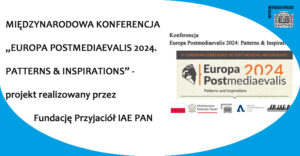
MIĘDZYNARODOWA KONFERENCJA „EUROPA POSTMEDIAEVALIS 2024. PATTERNS & INSPIRATIONS” - projekt realizowany przez Fundację Przyjaciół Instytutu Archeologii i Etnologii PAN
09 października 2023
Nataliacoments closed
MIĘDZYNARODOWA KONFERENCJA „EUROPA POSTMEDIAEVALIS 2024. PATTERNS & INSPIRATIONS” planowana jest w dniach 23-25 kwietnia 2024 r. Odbędzie się w Instytucie Archeologii i Etnologii Polskiej Akademii Nauk w Warszawie oraz na Wydziale Archeologii Uniwersytetu Warszawskiego. Jest to czwarte z wydarzeń naukowych, organizowanych cyklicznie co dwa lata z inicjatywy międzynarodowego stowarzyszenia "Europa Postmediaevalis Research Group", w wybranych, europejskich ośrodkach akademickich. Konferencje skupiają wiodących badaczy specjalizujących się w studiach nad kulturą materialną okresu nowożytnego (tj. z XV/XVI-XIX w.), zwłaszcza nad szeroko pojętymi wyrobami ceramicznymi. Wybór Polski jako miejsca organizacji kolejnej sesji świadczy o znaczeniu wkładu polskich archeologów w studia nad kulturą materialną doby nowożytnej i zainteresowaniu zagranicznych naukowców polskimi badaniami i kolekcjami zabytków.
Archeologia okresu nowożytnego jest dyscypliną coraz prężniej rozwijającą się w ostatniej dekadzie, przede wszystkim ze względu na znaczenie tej epoki dla kształtowania się dzisiejszego, kulturowego i geopolitycznego obrazu Europy. Planowana konferencja nie tylko znakomicie wpisuje się w ten aktualny trend badawczy, ale jest też odpowiedzią na zapotrzebowanie międzynarodowego środowiska naukowego. Dlatego też głównym - obok prezentacji wyników najnowszych badań i znalezisk archeologicznych - celem konferencji jest integracja środowiska naukowego, zwłaszcza badaczy z krajów Europy środkowej i wschodniej. Obrady stworzą możliwość nie tylko wzmocnienia współpracy międzynarodowej, ale też podjęcia wspólnych projektów interdyscyplinarnych.
Obrady zaplanowano w ciągu trzech dni, w związku z czym liczbę aktywnych uczestników (referentów) ograniczono do około 40 osób. Konferencja planowana jest w formie hybrydowej (stacjonarnie i on-line). Obradom towarzyszyć będzie sesja posterowa. Przewidziane są także warsztaty ceramologiczne, pozwalające zapoznać się uczestnikom ze zbiorami znalezisk ceramiki z różnych stanowisk polskich, uzupełnione prezentacją kolekcji i wystaw archeologicznych w dwóch stołecznych instytucjach - w Muzeum Warszawy i w Zamku Królewskim. W zamyśle organizatorów działania te mają służyć także promocji dorobku polskich naukowców.
Partnerami Fundacji w realizacji niniejszego projektu są:
Instytut Archeologii i Etnologii Polskiej Akademii Nauk,
Wydział Archeologii Uniwersytetu Warszawskiego,
Stowarzyszenie "Europa Postmediaevalis Research Group"
Głównymi realizatorami projektu są:
dr Magdalena Bis,
dr Maciej Trzeciecki,
Projekt dofinansowany ze środków budżetu państwa, przyznanych przez Ministra Edukacji i Nauki w ramach Programu "Doskonała Nauka II"
Finansowanie projektu:
Ministerstwo Edukacji i Nauki,
Instytut Archeologii i Etnologii Polskiej Akademii Nauk,
Wydział Archeologii Uniwersytetu Warszawskiego.



